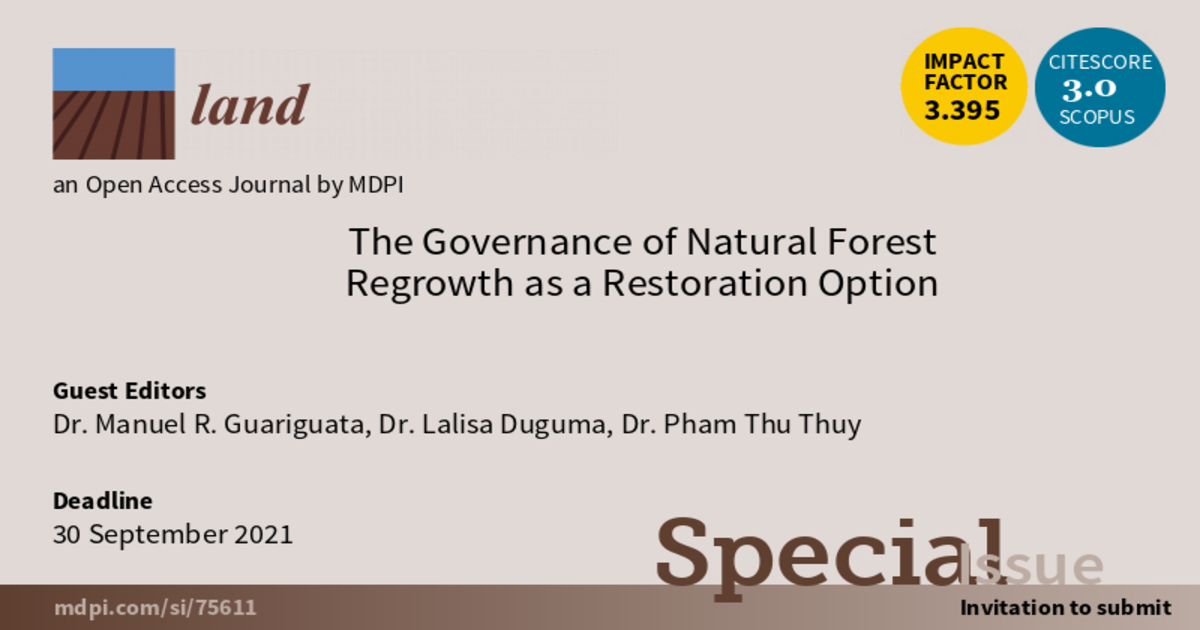The Governance of Natural Forest Regrowth as a Restoration Option
A special issue of Land (ISSN 2073-445X).
Deadline for manuscript submissions: closed (31 December 2021) | Viewed by 11020

Special Issue Editors
Interests: ecology and management of natural and restored tropical forests; multiple forest use; secondary forest succession; international forest policy; forest governance; monitoring; adaptive management; tropical silviculture
Special Issues, Collections and Topics in MDPI journals
Interests: community-based resource management; forest policy and governance; landscape approaches
Special Issue Information
Dear Colleagues,
Forests which regenerate naturally on previously deforested land are important for the conservation of biodiversity and the mitigation of, and adaptation to, climate change. In the context of the global restoration agenda, natural forest regrowth is increasingly being recognized as an important “nature-based solution”. However, natural forest regrowth, as both a process and an outcome, often falls under the radar of land management norms and policies and socially inclusive environmental regulations, thus limiting its long-term conservation and sustainable use. This “invisibility”, often driven by cross-sectorial overlaps and technocratic approaches that ignore local needs and aspirations, impinges negatively on the livelihoods of forest- and agricultural-dependent people. Definitional issues often linked to classic mapping classifications such as forest/nonforest also contribute to the failure to consider naturally regrown forests in decision-making and land use planning objectives. Although a globally important restorative activity, the underlying requirements for implementing and effectively governing natural forest regrowth interventions differ from other related restoration practices. This Special Issue aims to provide a global overview of the key institutional, policy, regulatory and normative dimensions governing the process, and the socioecological outcomes, of natural forest regrowth, through either passive or assisted processes.
Suggested topics
- The persistence of naturally regenerated forests: policy and normative issues;
- Land sparing vs. land sharing: implications for the long-term persistence of natural forest regrowth;
- Large-scale restoration through natural forest regrowth: challenges and opportunities;
- Research capacity and curricular development in the context of natural forest regrowth;
- Innovative business models, incentive schemes and their socioeconomic effectiveness;
- Intersectorial conflicts and concordances on the governance of naturally regenerated forests;
- Agrarian reform and drivers of natural forest regeneration;
- The role of natural forest regrowth in national restoration targets at multiple scales;
- Socioecological mapping and classification of natural forest regrowth;
- Dynamics of the urban-to-rural nexus and the fate of naturally regrown forests;
- Extrasectorial policies influencing the development and permanence of naturally regenerated forests;
- The governance of carbon stocks in the context of natural forest regrowth.
Dr. Manuel R. Guariguata
Dr. Lalisa Duguma
Dr. Pham Thu Thuy
Guest Editors
Manuscript Submission Information
Manuscripts should be submitted online at www.mdpi.com by registering and logging in to this website. Once you are registered, click here to go to the submission form. Manuscripts can be submitted until the deadline. All submissions that pass pre-check are peer-reviewed. Accepted papers will be published continuously in the journal (as soon as accepted) and will be listed together on the special issue website. Research articles, review articles as well as short communications are invited. For planned papers, a title and short abstract (about 100 words) can be sent to the Editorial Office for announcement on this website.
Submitted manuscripts should not have been published previously, nor be under consideration for publication elsewhere (except conference proceedings papers). All manuscripts are thoroughly refereed through a single-blind peer-review process. A guide for authors and other relevant information for submission of manuscripts is available on the Instructions for Authors page. Land is an international peer-reviewed open access monthly journal published by MDPI.
Please visit the Instructions for Authors page before submitting a manuscript. The Article Processing Charge (APC) for publication in this open access journal is 2600 CHF (Swiss Francs). Submitted papers should be well formatted and use good English. Authors may use MDPI's English editing service prior to publication or during author revisions.
Keywords
- natural forest regrowth
- forest and landscape restoration
- forest classification
- policies
- incentives







